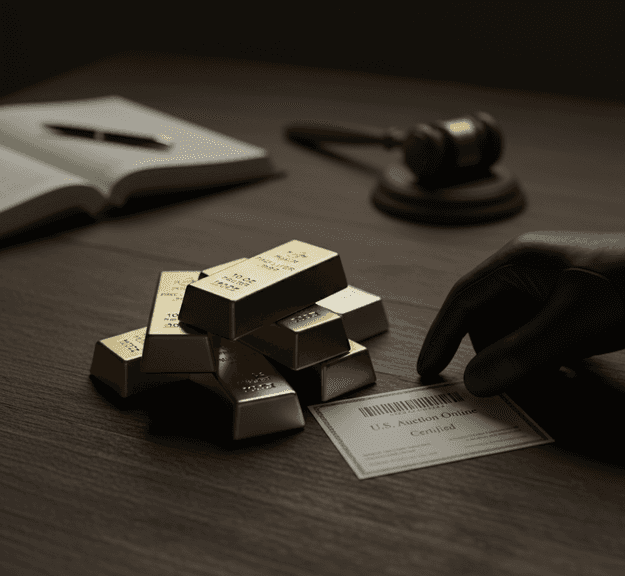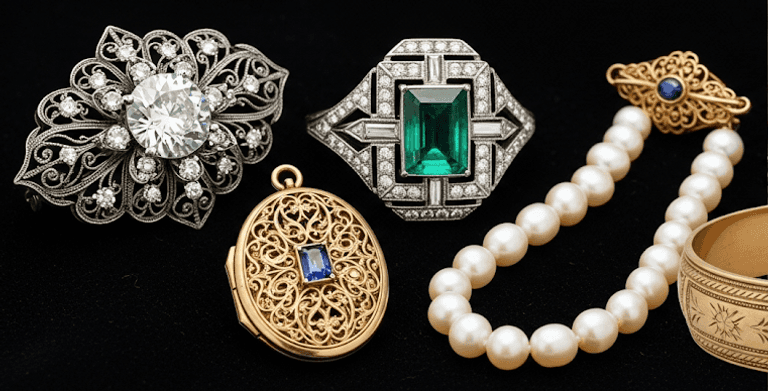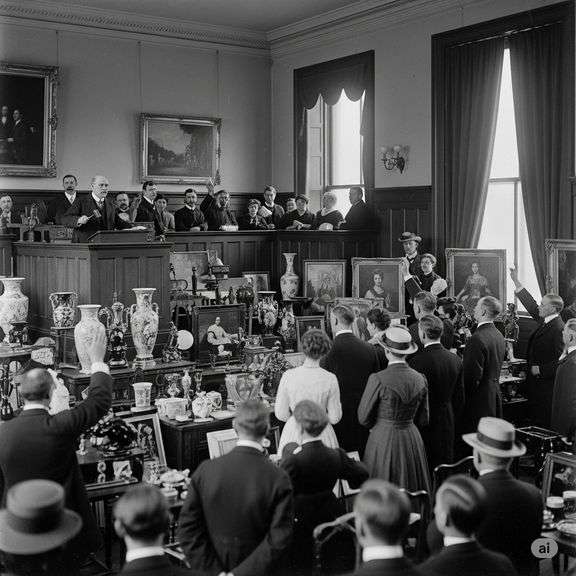
The Collector’s Guide to Fine Art at Online Auctions
The Collector’s Guide to Fine Art at Online Auctions Fine art collecting has shifted from an exclusive activity for insiders and wealthy buyers to an open, transparent marketplace. Now, anyone with passion and curiosity can pursue collecting. The digital revolution has democratized access, enabling broader participation in this enriching pursuit. Online auction platforms now allow you to discover museum-quality pieces, invest in emerging talent, and acquire works from established artists, all from home. Whether expanding a collection or starting fresh, online auctions open new possibilities, making art more attainable than ever for collectors and investors alike. At U.S. Auction Online , we've witnessed firsthand how this democratization has transformed lives and collections. Our platform brings together fine art from estate closures, bankruptcy proceedings, loan defaults, and legal seizures, creating a unique marketplace where exceptional pieces find new homes with collectors who truly appreciate them. This guide will walk you through everything you need to know about navigating the exciting world of fine art at online auctions, empowering you to collect with confidence and knowledge. Understanding Fine Art at Online Auctions The term "fine art" encompasses a rich spectrum of creative works, and understanding the distinctions between different types is essential for making informed collecting decisions. Let's explore the landscape of what you'll encounter in the online auction environment. Original Artworks vs. Prints Original artworks represent one-of-a-kind creations, the actual piece that emerged from the artist's hand, whether it's an oil painting on canvas, a watercolor on paper, or a sculpture carved from marble. These pieces carry inherent uniqueness and typically command higher values due to their singular nature. When you acquire an original, you're obtaining the primary source of the artist's vision, complete with the texture of brushstrokes, the layering of materials, and the subtle imperfections that make it irreplaceable. Prints, conversely, are reproductions created through various techniques such as lithography, serigraphy (screen printing), etching, or giclée printing. However, don't let the word "reproduction" diminish their value in your mind. Fine art prints, particularly those created under the artist's supervision or as part of their intended artistic output, hold significant collectible value. Many renowned artists, from Rembrandt to Warhol, considered printmaking an essential part of their artistic practice, not merely a way to reproduce existing works. Explore our fine arts original and print collection . Limited Editions and Their Numbering When exploring prints and certain sculptures, you'll encounter limited edition numbering, typically expressed as a fraction like "25/100." The first number indicates which piece in the series you're acquiring, while the second represents the total number produced. This numbering system serves multiple purposes: it guarantees scarcity, protects value, and provides transparency about the work's exclusivity. Lower numbers in a series sometimes carry premium value among collectors, though the artistic quality remains identical throughout the edition. Additionally, you may encounter designations like "A/P" (Artist's Proof) or "H/C" (Hors Commerce), which indicate special copies outside the numbered edition, often reserved for the artist or not intended for sale. These can be particularly desirable to knowledgeable collectors. Check out our limited edition artworks. Framed vs. Unframed Pieces The decision between framed and unframed artwork involves both practical and aesthetic considerations. Framed pieces offer immediate display-readiness and protection, allowing you to hang your acquisition the moment it arrives. Quality framing also preserves the artwork, protecting it from environmental damage, UV exposure, and physical harm. When a piece comes with original or period-appropriate framing, this can add historical value and authenticity to the work. Unframed pieces, meanwhile, provide flexibility and often represent better value. You can select custom framing that perfectly complements your décor, matches other pieces in your collection, or reflects your personal aesthetic preferences. Professional framing costs vary widely based on materials and complexity, so factor this into your budget when considering unframed works. For collectors building cohesive gallery walls, purchasing unframed pieces and framing them uniformly can create stunning visual harmony. Various Mediums: A World of Possibilities Fine art manifests in countless mediums, each with distinct characteristics, care requirements, and market dynamics: Paintings: Span oil, acrylic, watercolor, gouache, and mixed media on surfaces ranging from canvas to wood panels to paper. Oil paintings often command premium prices due to their historical prestige and longevity, while acrylics offer vibrant colors and modern appeal. Works on Paper: Include drawings, watercolors, pastels, and mixed media pieces. These require careful handling and proper framing with UV-protective glass, but they offer intimate glimpses into an artist's process and often represent more accessible entry points for new collectors. Sculptures: Range from traditional bronze castings and marble carvings to contemporary installations using unconventional materials. Three-dimensional works add dramatic presence to collections and spaces. Photography: Has gained significant recognition as fine art, with vintage prints and limited edition photographs from master photographers commanding substantial prices. Understanding these distinctions helps you evaluate which types align with your collecting goals, available space, budget, and personal aesthetic preferences. Researching and Evaluating Artworks Thorough research is crucial when buying fine art online. Use these steps to evaluate pieces: Artist Background: Search databases like Artnet for career details, past sales, and market trends. Provenance Check: Request ownership history and certificates of authenticity (COA). Condition Review: Examine high-res photos and reports for damage or restorations. Market Comparison: Analyze comparable sales to assess value. Personal Fit: Consider how it aligns with your space and collection theme. Navigating Artistic Value: Emerging vs. Established Artists One of the most exciting aspects of collecting fine art involves deciding where to focus your attention and resources along the spectrum from emerging to established artists. Both categories offer distinct advantages, and many sophisticated collectors maintain balanced portfolios incorporating both. The Appeal of Emerging and New Artists Collecting works by emerging artists offers the thrill of discovery and the satisfaction of supporting creative talent at the beginning of their journey. These artists are actively developing their voice, experimenting with techniques, and building their reputations. For collectors, this presents several compelling advantages. Affordability stands as the most obvious benefit. Emerging artists' works typically carry price points that make building a substantial collection feasible for collectors with modest budgets. You can acquire multiple pieces, experiment with different styles, and develop your eye without significant financial risk. Beyond economics, there's genuine excitement in discovering talent before the broader market recognizes it. You become part of the artist's story, and if their career flourishes, your early acquisitions may appreciate significantly in value. Some of today's most celebrated artists were once unknowns whose early supporters acquired masterpieces for modest sums. Emerging artists also tend to be more accessible. You might communicate directly with them, learn about their inspiration and process, and develop relationships that deepen your connection to the work. This personal dimension adds immeasurable richness to the collecting experience. The Security of Established Artists Established artists bring proven track records, market stability, and immediate recognition value. Their works have withstood critical scrutiny, maintained market demand over time, and earned places in museums, important collections, and art historical discourse. When you acquire work by an established artist, you're investing in documented value. Extensive sales records, auction results, and scholarly attention provide transparency about pricing and market trends. This makes established artists particularly appealing for collectors viewing art as an investment component of their financial portfolio. Established artists also offer the prestige and conversation-starting power that comes with recognized names. A Chagall lithograph or a Miró print carries instant cultural cachet and serves as a focal point in any collection or space. Art Movements and Styles: Finding Your Aesthetic The history of art unfolds through movements and styles, each representing distinct philosophical approaches, techniques, and aesthetic values. Understanding these categories helps you identify what resonates with your sensibilities and guides your collecting focus. Impressionism and Post-Impressionism These late 19th and early 20th-century movements revolutionized art by emphasizing light, color, and immediate visual impressions over precise detail. Impressionist works feature visible brushstrokes, emphasis on natural light, and often depict outdoor scenes and everyday life. Post-Impressionists like Van Gogh and Cézanne built upon these foundations while introducing more symbolic content and structural experimentation. These styles remain perennially popular with collectors who appreciate their beauty, historical significance, and emotional warmth. Modern Art The modern period (roughly 1860s-1970s) encompasses numerous sub-movements, including Cubism, Surrealism, Expressionism, and Abstract Expressionism. Modern art challenged traditional representation, explored psychological depths, and experimented with form, color, and composition in revolutionary ways. Collectors drawn to modern art often appreciate intellectual complexity, bold innovation, and works that provoke thought as much as they please the eye. Abstract and Color Field Abstract art abandons representational imagery entirely, focusing instead on form, color, line, and texture as subjects in themselves. Color Field painting, a subset of abstract art, emphasizes large areas of flat, solid color, creating contemplative, immersive experiences. These styles appeal to collectors who value pure aesthetic experience, meditative qualities, and works that complement contemporary architecture and design. Contemporary Art Contemporary art encompasses work created from the 1970s to the present, reflecting our current cultural moment with all its diversity, technology, and global perspectives. This category is remarkably broad, including everything from photorealism to conceptual art to digital media. Contemporary art appeals to collectors who want their collections to reflect current dialogues, support living artists, and engage with pressing social and cultural issues. Traditional and Representational Art Despite modernism's innovations, traditional representational art, landscapes, portraits, still lifes, and figurative works remain beloved by many collectors. These works offer immediate accessibility, technical virtuosity, and timeless appeal. They complement both traditional and contemporary interiors and provide enduring pleasure through their craftsmanship and beauty. Art Investment in the Digital Era The perception of art as a legitimate investment asset class has grown dramatically in recent decades, and online auctions have played a crucial role in this evolution. While art should never be collected purely for financial returns, the pleasure of living with beautiful, meaningful objects should always factor into your decision, understanding art's investment potential adds another dimension to informed collecting. The Growing Legitimacy of Art as Investment Financial advisors increasingly recognize art's role in diversified portfolios. Unlike stocks or bonds, art provides tangible assets with intrinsic aesthetic value. It doesn't correlate directly with traditional financial markets, offering protection against market volatility. Quality artworks have demonstrated remarkable value retention and appreciation over long time horizons, with certain categories outperforming many conventional investments. The global art market now exceeds $65 billion annually, with robust infrastructure supporting valuation, authentication, insurance, and resale. This maturation has attracted serious investors who appreciate art's unique combination of financial potential and personal enjoyment. Learn more about art as an investment . Benefits of Buying Fine Art at Online Auctions The advantages of acquiring fine art through online auctions extend far beyond mere convenience, fundamentally transforming the collecting experience in ways that benefit both newcomers and experienced collectors. Convenience and Accessibility: Online auctions eliminate geographical barriers that once limited collecting to those near major art centers. Whether you live in a metropolitan area with abundant galleries or a rural community with limited local options, you have equal access to quality fine art. Browse auctions during your lunch break, research pieces late at night, and participate in sales from anywhere with internet access. This flexibility allows you to collect on your schedule, without the pressure of gallery hours or the need to travel to auction houses. Competitive Pricing and Value Opportunities: The online auction format creates natural price discovery through competitive bidding. Unlike fixed-price gallery settings, where negotiation may feel uncomfortable or unwelcome, auctions establish value through transparent market dynamics. Multiple interested parties bidding on the same piece ensure that final prices reflect genuine market demand. Diverse Inventory from Various Sources: Online auction houses, particularly those like U.S. Auction Online that source from estates, loan defaults, bankruptcies, and seizures, offer remarkable inventory diversity. Each week brings fresh opportunities as new consignments arrive from different sources. This variety means you're not limited to what a single gallery owner chose to stock or what one estate happens to contain. Instead, you access a constantly refreshing marketplace reflecting the full spectrum of collecting possibilities. Transparent Pricing History and Bidding: Online platforms provide visibility into pricing history and current bidding activity that traditional auction formats often obscure. You can research what similar pieces have sold for, track how bidding progresses on items of interest, and make informed decisions based on comprehensive information. This transparency protects buyers from overpaying and ensures that market values reflect genuine demand rather than artificial scarcity or information asymmetry. Weekly New Auctions with Fresh Opportunities: Unlike galleries with relatively static inventory or traditional auction houses with quarterly sales, online platforms typically feature weekly or even daily auctions. This regular cadence means you don't need to wait months for the next opportunity. Miss out on a piece this week? Next week brings entirely new possibilities. This rhythm keeps collecting exciting and dynamic elements while providing regular opportunities to add to your collection. Understanding Costs and Fees in Online Fine Art Auctions Beyond the final bid price, several costs apply when buying fine art online: Buyer's Premium: A fee will be added to the hammer price for auction services. Taxes and Duties: Sales tax based on your location; international purchases may incur customs duties. Shipping and Insurance: Varies by size and value, typically 10-20% of the total; includes specialized packing. Other Fees: Potential charges for payment methods (e.g., credit card surcharges) or extended storage. After the Auction: Payment, Shipping, and Care Once you've won a bid, follow these steps for a smooth transition: Payment: Settle promptly via secure options like bank transfer or credit card. U.S. Auction Online accepts multiple methods with clear deadlines. Shipping: Use our partnered services for insured, professional packaging and delivery. Track shipments in real-time. Insurance and Care: Insure your piece upon arrival and store it in climate-controlled spaces. Consult conservators for maintenance. Display: Frame or mount as needed, considering UV protection and lighting. Addressing Common Concerns Despite the many advantages of online art auctions, potential buyers often harbor legitimate concerns about purchasing fine art without the traditional in-person experience. Let's address these concerns comprehensively, providing you with the knowledge to collect with confidence. Authenticity and Provenance: Ensuring Genuine Artworks Authenticity represents the paramount concern for any art collector. How can you trust that a piece is genuinely created by the attributed artist, especially when purchasing online? Reputable online auction houses employ multiple verification methods. Professional appraisers and art experts examine pieces before listing, looking for signatures, dating techniques, materials consistent with the artist's known work, and stylistic elements that confirm attribution. Documentation accompanying the artwork, certificates of authenticity, gallery receipts, exhibition history, and previous auction records provide crucial provenance that traces the work's ownership history. Provenance serves as an artwork's biography, documenting its journey from the artist's studio to the present day. Strong provenance not only confirms authenticity but also adds historical value and interest. Look for pieces with clear ownership records, particularly those that include reputable galleries, known collectors, or institutional exhibitions in their history. For prints and limited editions, documentation should include the edition number, publisher information, and ideally, certificates of authenticity from the publisher or artist. Established artists working with reputable publishers maintain detailed records that can be verified. When evaluating authenticity, consider the source. Artworks from estate sales often come with decades of ownership history and documentation accumulated by the original collector. Pieces from gallery bankruptcies typically include the gallery's authentication and provenance records. These sourcing circumstances provide additional confidence in authenticity. Condition Assessment: Evaluating Quality Remotely Assessing an artwork's condition without physical examination requires detailed visual documentation and comprehensive descriptions. Reputable online auction houses provide: High-Resolution Photography: Multiple images from various angles, including close-ups of signatures, details, and any condition issues Detailed Descriptions: Comprehensive written assessments noting dimensions, medium, condition, framing details, and any damage or restoration Condition Reports: Professional evaluations documenting the work's state, including any tears, stains, fading, foxing (age spots on paper), craquelure (fine cracks in paint), or other condition considerations Learn to read photographs critically. Look for even lighting that reveals the work's true colors and surface texture. Examine edges and corners where damage often occurs. For works on paper, check for discoloration, water damage, or acid burn from poor framing materials. Don't hesitate to request additional information. Reputable auction houses welcome questions and can provide supplementary photographs or details about specific condition concerns. Ask about previous restoration, storage conditions, and whether the work has been examined under UV light (which can reveal repairs or alterations invisible to the naked eye). Understanding condition terminology helps you evaluate listings accurately. Terms like "excellent," "very good," "good," and "fair" have specific meanings in the art world. Minor condition issues don't necessarily diminish a work's collectability; many antique and vintage pieces show age-appropriate wear that's expected and accepted. However, you should understand exactly what you're acquiring. For quick answers about grading and condition terms, visit our FAQ page. Buyer Protection: Returns, Guarantees, and Recourse Understanding your protections as a buyer provides essential peace of mind. What happens if a piece arrives damaged, doesn't match its description, or proves to be misattributed? Reputable auction houses offer comprehensive buyer protection policies, including: Authenticity Guarantees: Assurances that pieces are genuine as described, with recourse if authenticity is later questioned Condition Guarantees: Commitments that items match their described condition Return Policies: Timeframes and procedures for returning pieces that don't meet expectations Damage Protection: Policies addressing items damaged during shipping Dispute Resolution: Clear processes for addressing concerns and resolving disagreements Read these policies carefully before bidding. Understand the timeframe for reporting issues, the documentation required for returns, and any conditions or limitations. Legitimate auction houses stand behind their merchandise and want satisfied customers who return for future purchases. Pricing and Value: Ensuring Fair Market Value How do you know whether you're paying a fair price for an artwork? Online auctions actually provide significant advantages for value assessment. Research comparable sales using online databases, auction result archives, and the auction house's own historical data. Look for similar works by the same artist, same medium, similar size, comparable condition, and note their selling prices. This comparative analysis reveals market ranges and helps you establish reasonable expectations. Consider the artwork's characteristics that influence value: artist reputation, size, medium, condition, subject matter, provenance, and rarity. A small watercolor sketch naturally commands less than a large oil painting by the same artist. Works with exhibition history or prestigious provenance carry premiums over similar pieces without such documentation. The auction format itself provides value protection. If you're the only bidder interested in a piece, you'll acquire it at or near the minimum price. If multiple collectors compete, the final price reflects genuine market demand. This transparent price discovery mechanism ensures you're paying what the market determines the piece is worth at that moment. Getting Started with Fine Art Online Auctions at U.S. Auction Online Embarking on your journey into buying fine art online is straightforward. Here's a step-by-step guide to help you begin: Register an Account: Visit U.S. Auction Online and create a free account. Provide basic information and verify your identity to access catalogs and bidding features. Browse Catalogs: Explore upcoming auctions by selecting the Art Category . Use search tools to find specific artists or styles. Familiarize with the Platform: Review tutorials or help sections on how the site works, including timed vs. live online auctions. Starting small with affordable pieces can build your confidence. For more tips, check our “ How Auctions Work ” in our blog section. Conclusion: Your Journey in Fine Art Collecting Begins Here The world of fine art collecting offers rewards that extend far beyond financial considerations. Living with beautiful, meaningful artworks enriches daily life, provides endless opportunities for discovery and learning, connects you with human creativity across cultures and centuries, and allows you to support artists whose vision moves you. Whether you're drawn to the serene beauty of Impressionist landscapes, the bold innovation of abstract expressionism, the technical mastery of traditional realism, or the cutting-edge experimentation of contemporary art, collecting allows you to surround yourself with objects that inspire, comfort, challenge, and delight. Online auctions have democratized this once-exclusive pursuit, removing barriers of geography, insider access, and intimidating gallery environments. Today, anyone with curiosity, passion, and a willingness to learn can build a meaningful collection. The knowledge you've gained from this guide, understanding different types of artworks, navigating the emerging versus established artist decision, recognizing various movements and styles, appreciating art's investment potential, and knowing how to address common concerns, empowers you to collect with confidence. At U.S. Auction Online , we're honored to serve as your partner in this journey. Our commitment to authenticity, transparency, buyer protection, and exceptional value makes us the trusted destination for collectors at every level. Our weekly auctions bring fresh opportunities to discover pieces that speak to your aesthetic sensibilities and collecting goals. Our comprehensive guarantees and customer support ensure that every purchase meets your expectations. And our unique sourcing model delivers access to quality fine art at values that make building substantial collections achievable. The perfect piece for your collection might appear in this week's auction. The emerging artist whose work resonates with you could be featured in next week's sale. The established master you've always admired might become accessible through an estate consignment arriving next month. Each auction brings new possibilities, and each acquisition adds another chapter to your collecting story. We invite you to explore our current fine art auctions , discover pieces that move you, and take the next step in your collecting journey. Whether you're acquiring your first artwork or your hundredth, whether you're investing thousands or starting modestly, whether you're drawn to contemporary innovation or classical beauty, U.S. Auction Online provides the platform, protection, and possibilities to collect with confidence. Your collection awaits. The art world has never been more accessible, transparent, or exciting. Welcome to the future of fine art collecting, welcome to U.S. Auction Online . Read More














